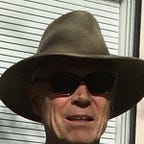Consistently Godel
I. Aside from the fact that I blatantly copied Robert Zimmerman’s Motorpsyscho Nightmare word-for-word with no apology because this is the best way I can honor the real Poet Laureate of this country, I consider this collage piece one of my more creative works. The ideas bounce around a lot: a short explanation of Kurt Godel’s math-shattering Incompleteness Theorems, a look at yours truly at 31 (barely employed but in great shape), some cartoons I did for a local ‘organic’ food store, a poem I wrote (you can borrow it, Bob), a brief look at the process of taking the derivative of the derivative of the… The print is too small as are some of my little characters, but if one squints hard enough, the Truth will be Seen. Or not.
II. another take — Consistently Godel:
Since the time of the philosopher/king in ancient Greece, philosophers combined all of the science then available with philosophy and religion to make bold predictions involving comets, the weather, and warfare. Plato, Aristotle, Pythagoras, Euclid, and others laid much of their precise description of the universe and the mind (epistemology) upon mathematics, especially geometry. Geometry is the birthplace of modern proof theory; hence, the short proof using the diameter of a circle to show the relationship between the arithmetic and geometric means. By the time Godel happened upon the academic world, mathematics was considered the final bastion of exactitude, clarity, logical completeness, and logical consistency. There is some mathematics in the piece involving calculus derivatives, that has both geometry and logic in its development simply as an example.
Around 1930 the civilized world was experiencing major paradigm shifts across all fronts, including mathematics. Kurt Godel amplified this change by successfully challenging the very roots of mathematics — logic, itself, and he did so in a subtle but profound way. To abridge the story a bit, recall the Liar’s Paradox, “This statement is a lie.” Is it true? If so, then it is, indeed, a lie and not true. Is it untrue? If so then it is not a lie — it is a truth. Either way we run into a contradiction. If this were all written out in mathematical logic, it would present a devastating dilemma and surely put all of mathematics under a spotlight.
That’s what Godel effectively did. He imbedded the Liar Paradox into mathematical logic. He proved that there was a theorem (a true statement) that could not be proven true. Which statement? The previous statement. Part of his cleverness involved writing his ideas out in metamathematics (like English) and then assigning a unique numbering system to each and every symbol in the ‘higher level’ language. He thus transformed what is typically considered a Natural language using an alphabet similar to English into a Formal language similar to mathematics. His monumental work was published as his Incompleteness Theorems, but as the title of this piece indicates, he also placed the concept of Inconsistency into focus by showing that both A and not A were possible in the existing system.
The remaining parts of this piece, Consistently Godel, are poems (one by Bob Dylan, one by yours truly), cartoons and so on, that are included for their point (Dylan’s character finds himself in the middle of chaos) and counterpoint (my silly story just to lighten the moment).
Some of this was constructed a month ago, and some was created 50 years ago. I wanted it to come together in one episodic product, this piece.
Russ
